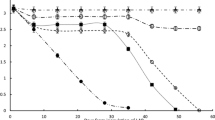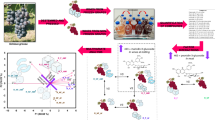Abstract
Spine grapes (Vitis daviddi Foex) are cultivated in southern China and possess a unique taste and flavor. However, nitrogen-deficiency results in poor quality spine wine. Diammonium phosphate (DAP) was added to spine grape must to determine the effect of DAP supplementation on the evolution of amino acids and associated by-products. DAP addition increased concentrations of amino acids from 73.5 to 101.0mg/L and biogenic amines from 3.9 to 5.0mg/L, but decreased concentrations of higher alcohols from 322.3 to 273.8mg/L and ethyl carbamate from 16.0 to 10.2 μg/L after fermentation. Sensory evaluation revealed that DAP supplementation kept the unique aroma and taste of fresh spine wine. DAP supplementation can benefit spine grape vinification and improve the quality of fresh spine wine.
Similar content being viewed by others
References
Liang NN, Pan QH, He F, Wang J, Reeves MJ, Duan CQ. Phenolic profiles of Vitis davidii and Vitis quinquangularis species native to China. J. Agr. Food Chem. 61: 6016–6027 (2013)
Nisbet MA, Martinson TE, Mansfield AK. Accumulation and prediction of yeast assimilable nitrogen in New York wine grape cultivars. Am. Enol. Viticult. 65: 325–332 (2014)
Meng JF, Xu TF, Song CZ, Li XL, Yue TX, Qin MY, Fang YL, Zhang ZW, Xi ZM. Characteristic free aromatic components of nine clones of spine grape (Vitis davidii Foex) from Zhongfang County (China). Food Res. Int. 54: 1795–1800 (2013)
Magasanik B, Kaiser CA. Nitrogen regulation in Saccharomycescerevisiae. Gene 290: 1–18 (2002)
Bell SJ, Henschke PA. Implications of nitrogen nutrition for grapes, fermentation and wine. Aust. J. Grape Wine R. 11: 242–295 (2005)
Bindon KA, Kassara S, Cynkar WU, Robinson EMC, Scrimgeour N, Smith PA. Comparison of extraction protocols to determine differences in wineextractable tannin and anthocyanin in Vitis vinifera L. cv. Shiraz and Cabernet Sauvignon grapes. J. Agr. Food Chem. 62: 4558–4570 (2014)
Monteiro FF, Bisson LF. Nitrogen supplementation of grape juice. I. Effect on amino acid utilization during fermentation. Am. Enol. Viticult. 43: 1–10 (1992)
Adams C, van Vuuren HJ. Effect of timing of diammonium phosphate addition tofermenting grape must on the production of ethyl carbamate in wine. Am. Enol. Viticult. 61: 125–129 (2010)
Herbert P, Cabrita MJ, Ratola N, Laureano O, Alves A. Free amino acids and biogenic amines in wines and musts from the Alentejo region. Evolution of amines during alcoholic fermentation and relationship with variety, subregion and vintage. J. Food Eng. 66: 315–322 (2005)
Guitart A, Orte PH, Ferreira V, Peña C, Cacho J. Some observations about the correlation between the amino acid content of musts and wines of the Chardonnay variety and their fermentation aromas. Am. Enol. Viticult. 50: 253–258 (1999)
Leitao MC, Marques AP, San Romao MV. A survey of biogenic amines in commercial Portuguese wines. Food Control 16: 199–204 (2005)
Weber JV, Sharypov VI. Ethyl carbamate in foods and beverages: A review. Environ. Chem. Lett. 7: 233–247 (2009)
OIV. 2015. Compendium of international methods of wine and must analysis. Vol. 1. Organisation International de la Vigne et du Vin, Paris, France (2015)
Gil-Muñoz R, Gómez-Plaza E, Martýnez A, López-Roca JM. Evolution of the CIELAB and other spectrophotometric parameters during wine fermentation. Influence of some pre and postfermentative factors. Food res. Int. 30: 699–705 (1997)
Gómez-Alonso S, Hermosín-Gutiérrez I, García-Romero E. Simultaneous HPLC analysis of biogenic amines, amino acids, and ammonium ion as aminoenone derivatives in wine and beer samples. J. Agr. Food Chem. 55: 608–613 (2007)
AQSIQ and SAC. 2003. Method for analysis of hygienic standard of distilled wines and mixed wines. 2nd ed. GB/T 5009.48-2003. General Administration of Quality Supervision, Inspection and Quarantine of the People’s Republic of China and Standardization Administration of China, Beijing, China (2003)
AQSIQ. 2012. Determination of ethyl cabarmate residues in alcohol for export-GC-MS. 2nd ed. SN/T 0285-2012. General Administration of Quality Supervision, Inspection and Quarantine of the People’s Republic of China, Beijing, China (2012)
Cretenand J. Tasting cards in international wine competitions. J. Int. Sci. Vigne. Vin. 33: 99–106 (2000)
Alimardani-Theuil P, Gainvors-Claisse A, Duchiron F. Yeasts: An attractive source of pectinases-from gene expression to potential applications: A review. Process Biochem. 46: 1525–1537 (2011)
Lonvaud-Funel A. Biogenic amines in wines: role of lactic acid bacteria. FEMS Microbiol. Lett. 199: 9–13 (2001)
Gardini F, Zaccarelli A, Belletti N, Faustini F, Cavazza A, Martuscelli M, Mastrocola D, Suzzi G. Factors influencing biogenic amine production by a strain of Oenococcus oeni in a model system. Food Control 16: 609–616 (2005)
Ough CS, Crowell EA, Mooney LA. Formation of ethyl carbamate precursors during grape juice (Chardonnay) fermentation. I. Addition of amino acids, urea, and ammonia: Effects of fortification on intracellular and extracellular precursors. Am. Enol. Viticult. 39: 243–249 (1988)
Masqué MC, Soler M, Zaplana B, Franquet R, Rico S, Elorduy X, Puig A, Bertran E, Capdevila F, Palacios AT, Romero SV, Heras JM, Krieger-Weber S. Ethyl carbamate content in wines with malolactic fermentation induced at different points in the vinification process. Ann. Microbiol. 61: 199–206 (2011)
Author information
Authors and Affiliations
Corresponding author
Rights and permissions
About this article
Cite this article
Jin, Q., Chen, L., Li, Z. et al. Effect of diammonium phosphate supplementation on the amino acid metabolism during fermentation and sensory properties of fresh spine grape (Vitis davidii Foex) wine. Food Sci Biotechnol 24, 2051–2057 (2015). https://doi.org/10.1007/s10068-015-0273-y
Received:
Revised:
Accepted:
Published:
Issue Date:
DOI: https://doi.org/10.1007/s10068-015-0273-y




